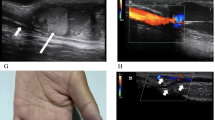Abstract
The purpose of this study was to evaluate the efficacy and safety of a new hydrodynamic percutaneous thrombectomy catheter in the treatment of thrombosed hemodialysis fistulas and grafts. Twenty-two patients (median age: 47 years; range: 31–79 years) underwent mechanical thrombectomy for thrombosed hemodialysis fistulas or polytetrafluoroethylene (PTFE) grafts. In all cases, an Oasis hydrodynamic catheter was used. Five patients had native fistulas and 17 had PTFE grafts. Six patients required repeat procedures. All patients with native fistulas and 15 of the 17 with PTFE grafts also underwent angioplasty of the venous limb following the thrombectomy. Major outcome measures included technical success, clinical success, primary and secondary patency, and complication rates. Twenty-eight procedures were performed in total. The technical success rate was 100% and 90% and clinical success was 86% and 76% for native fistulas and grafts, respectively. The primary patency at 6 months was 50% and 59% for fistulas and grafts, respectively, and the secondary patency at 6 months was 75% and 70% for fistulas and grafts, respectively. Two patients died of unrelated causes during the follow-up period. The Oasis catheter is an effective mechanical device for the percutaneous treatment of thrombosed hemodialysis access. Our initial success rate showed that the technique is safe in the treatment of both native fistulas and grafts.








Similar content being viewed by others
References
Ascher E, Hingorani A (2004) The dialysis outcome and quality initiative (DOQI) recommendations. Semin Vasc Surg 17:3–9
Liang H, Pan H, Chung H, et al. (2002) Restoration of thrombosed Brescia-Cimino dialysis fistulas by using percutaneous angioplasty. Radiology 223:339–344
Zibari GB, Rohr MS, Landreneau MD, et al. (1988) Complications from permanent hemodialysis vascular access. Surgery 104 681–686
Vorwerk D, Konner K, Schürmann K, et al. (1997) A simple trick to facilitate bleeding control after percutaneous hemodialysis fistula and graft interventions. Cardiovasc Intervent Radiol 20:159–160
Gray RJ, Sacks D, Martin LG, et al. (1999) Reporting standards for percutaneous interventions in dialysis access. Technology Assessment Committee. J Vasc Intervent Radiol 10:1405–1415
Poulain F, Raynaud A, Bourquelot P, et al. (1991) Local thrombolysis and thromboaspiration in the treatment of acutely thrombosed arteriovenous hemodialysis fistulas. Cardiovasc Intervent Radiol 14:98–101
Wildberger JE, Schmitz-Rode T, Haage P, et al. (2001) Ultrasound thrombolysis in hemodialysis access: In vitro investigation. Cardiovasc Intervent Radiol 24:53–56
Schmitz-Rode T, Bohndorf K, Günther RW (1993) New “mesh basket” for percutaneous removal of wall-adherent thrombi in dialysis shunts. Cardiovasc Intervent Radiol 16:7–10
Vesely TM (2003) Mechanical thrombectomy devices to treat thrombosed haemodialysis grafts. Tech Vasc Intervent Radiol 6:35–41
Winkler TA, Trerotola SO, Davidson DD, et al. (1995) Study of thrombus from thrombosed hemodialysis access grafts. Radiology 197:461–465
Barth KH, Gosnell MR, Palestrant AM, et al. (2000) Hydrodynamic thrombectomy system versus pulse-spray thrombolysis for thrombosed hemodialysis grafts: A multicenter prospective randomized comparison. Radiology 217:678–684
Höpfner W, Vicol C, Bohndorf K, et al. (1999) Shredding embolectomy thrombectomy catheter for treatment of acute lower-limb ischaemia. Ann Vasc Surg 13:426–435
Angle JF, Spinosa DJ, Hagspiel KD, et al. (2000) Management of acute lower extremity embolus with use of the oasis thrombectomy device and suction embolectomy. J Vasc Intervent Radiol 11:1331–1335
Bush RL, Lin PH, Lumsden AB (2004) Management of thrombosed dialysis access: Thrombectomy versus thrombolysis. Semin Vasc Surg 17:32–9
Haskal ZJ (2002) Mechanical thrombectomy devices for the treatment of peripheral arterial occlusions. Rev Cardiovasc Med 3(suppl 2):S45–S52
Vorwerk D, Shürmann K, Müller-Leisse C, et al. (1996) Hydrodynamic thrombectomy of haemodialysis grafts and fistulae: Results of 51 procedures. Nephrol Dial Transplant 11:1058–1064
Müller-Hülsbeck S, Grimm J, Leidt J, et al. (2002) In vitro effectiveness of mechanical thrombectomy devices for large vessel diameter and low-pressure fluid dynamic applications. J Vasc Intervent Radiol 13:831–839
Müller-Hülsbeck S, Bangard C, Schwarzenberg H, et al. (1999) In vitro effectiveness study of three hydrodynamic thrombectomy devices. Radiology 211:433–439
Vesely TM, Williams D, Weiss M, et al. (1999) Comparison of the angiojet rheolytic catheter to surgical thrombectomy for the treatment of thrombosed hemodialysis grafts. Peripheral AngioJet Clinical Trial. J Vasc Intervent Radiol 10:1195–1205
Rousseau H, Sapoval M, Ballini P, et al. (1997) Percutaneous recanalization of acutely thrombosed vessels by hydrodynamic thrombectomy (Hydrolyser). Eur Radiol 7:935–941
Overbosch EH, Pattynama PM, Aarts HJ, et al. (1996) Occluded hemodialysis shunts: Dutch multicenter experience with the hydrolyser catheter. Radiology 201:485–488
Pattynama PM, van Baalen J, Verburgh CA, et al. (1995) Revascularisation of occluded haemodialysis fistulae with the Hydrolyser thrombectomy catheter: Description of the technique and report of six cases. Nephrol Dial Transplant 10:1224–1227
Uflacker R, Rajagopalan PR, Selby JB, et al. (2004) Thrombosed dialysis access grafts: Randomized comparison of the Amplatz thrombectomy device and surgical thrombembolectomy. Eur Radiol 14:2009–2014
Trerotola SO, Lund GB, Scheel PJ Jr, et al. (1994) Thrombosed dialysis access grafts: Percutaneous mechanical declotting without urokinase. Radiology 191:721–726
Dolmatch BL, Gray RJ, Horton KM (1994) Will iatrogenic pulmonary embolisation be our pulmonary embarrassment? Radiology 191:615–617
van Ommen VG, van der Veen FH, Geskes GG, et al. (1996) Comparison of arterial wall reaction after passage of the Hydrolyser device versus a thrombectomy balloon in an animal model. J Vasc Intervent Radiol 7:451–454
Sharafuddin MJ, Hicks ME, Jenson ML, et al. (1997) Rheolytic thrombectomy with use of the AngioJet-F105 catheter: Preclinical evaluation of safety. J Vasc Intervent Radiol 8:939–945
Author information
Authors and Affiliations
Corresponding author
Rights and permissions
About this article
Cite this article
Sahni, V., Kaniyur, S., Malhotra, A. et al. Mechanical Thrombectomy of Occluded Hemodialysis Native Fistulas and Grafts Using a Hydrodynamic Thrombectomy Catheter: Preliminary Experience. Cardiovasc Intervent Radiol 28, 714–721 (2005). https://doi.org/10.1007/s00270-004-0292-1
Published:
Issue Date:
DOI: https://doi.org/10.1007/s00270-004-0292-1




